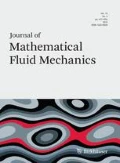Abstract
We consider initial-boundary value problems for the \(\kappa \)-dependent family of chemotaxis-(Navier–)Stokes systems
in a bounded domain \(\Omega \subset {\mathbb {R}}^3\) with smooth boundary and given potential function \(\phi \in C^{1+\beta }\!\left( {{\,\mathrm{{\overline{\Omega }}}\,}}\right) \) for some \(\beta >0\). It is known that for fixed \(\kappa \in {\mathbb {R}}\) an associated initial-boundary value problem possesses at least one global weak solution \((n^{(\kappa )},c^{(\kappa )},u^{(\kappa )})\), which after some waiting time becomes a classical solution of the system. In this work we will show that upon letting \(\kappa \rightarrow 0\) the solutions \((n^{(\kappa )},c^{(\kappa )},u^{(\kappa )})\) converge towards a weak solution of the Stokes variant \((\kappa =0)\) of the systems above with respect to the strong topology in certain Lebesgue and Sobolev spaces. We thereby extend the recently obtained result on the Stokes limit process for classical solutions in the two-dimensional setting to the more intricate three-dimensional case.
We’re sorry, something doesn't seem to be working properly.
Please try refreshing the page. If that doesn't work, please contact support so we can address the problem.
References
Amann, H.: Compact embeddings of vector-valued Sobolev and Besov spaces. Glas. Mat. Ser. III 35(55)(1), 161–177 (2000)
Bellomo, N., Bellouquid, A., Tao, Y., Winkler, M.: Toward a mathematical theory of Keller–Segel models of pattern formation in biological tissues. Math. Model. Methods Appl. Sci. 25(09), 1663–1763 (2015)
Chae, M., Kang, K., Lee, J.: Global existence and temporal decay in Keller–Segel models coupled to fluid equations. Commun. Partial Differ. Equ. 39(7), 1205–1235 (2014)
Di Nezza, E., Palatucci, G., Valdinoci, E.: Hitchhiker’s guide to the fractional Sobolev spaces. Bull. Sci. Math. 136(5), 521–573 (2012)
Duan, R., Xiang, Z.: A note on global existence for the Chemotaxis–Stokes model with nonlinear diffusion. Int. Math. Res. Not. IMRN 7, 1833–1852 (2014)
Duan, R., Lorz, A., Markowich, P.: Global solutions to the coupled chemotaxis-fluid equations. Commun. Partial Differ. Equ. 35(9), 1635–1673 (2010)
Giga, Y.: Solutions for semilinear parabolic equations in \(L_p\) and regularity of weak solutions of the Navier–Stokes system. J. Differ. Equ. 62(2), 186–212 (1986)
Giga, Y., Sohr, H.: Abstract \(L^p\) estimates for the Cauchy problem with applications to the Navier–Stokes equations in exterior domains. J. Funct. Anal. 102(1), 72–94 (1991)
Haroske, D.D., Triebel, H.: Distributions, Sobolev spaces, elliptic equations. EMS Textbooks in Mathematics, European Mathematical Society (EMS), Zürich (2008)
Henry, D.: Geometric Theory of Semilinear Parabolic Equations. Lecture Notes in Mathematics, vol. 840. Springer, Berlin (1981)
Ishida, S., Seki, K., Yokota, T.: Boundedness in quasilinear Keller–Segel systems of parabolic-parabolic type on non-convex bounded domains. J. Differ. Equ> 256(8), 2993–3010 (2014)
Keller, E.F., Segel, L.A.: Initiation of slime mold aggregation viewed as an instability. J. Theor. Biol. 26(3), 399–415 (1970)
Kozono, H., Miura, M., Sugiyama, Y.: Existence and uniqueness theorem on mild solutions to the Keller–Segel system coupled with the Navier–Stokes fluid. J. Funct. Anal. 270(5), 1663–1683 (2016)
Ladyženskaja, O.A., Solonnikov, V.A., Ural’ceva, N.N.: Linear and Quasilinear Equations of Parabolic Type. Translations of Mathematical Monographs. American Mathematical Society, Providence (1968)
Lankeit, J.: Long-term behaviour in a chemotaxis-fluid system with logistic source. Math. Model. Methods Appl. Sci. 26(11), 2071–2109 (2016)
Mendelson, N.H., Bourque, A., Wilkening, K., Anderson, K.R., Watkins, J.C.: Organized cell swimming motions in Bacillus subtilis colonies: patterns of short-lived whirls and jets. J. Bacteriol. 181(2), 600–609 (1999)
Miyakawa, T., Sohr, H.: On energy inequality, smoothness and large time behavior in \(L^2\) for weak solutions of the Navier–Stokes equations in exterior domains. Math. Z. 199(4), 455–478 (1988)
Mizoguchi, N., Souplet, Ph: Nondegeneracy of blow-up points for the parabolic Keller–Segel system. Ann. Inst. H. Poincaré Anal. Non Linéaire 31(4), 851–875 (2014)
Mizukami, M.: How strongly does diffusion or logistic-type degradation affect existence of global weak solutions in a chemotaxis-Navier–Stokes system? Z. Angew. Math. Phys. 70(2), 70:49 (2019)
Simon, J.: Compact sets in the space \({L}^p(0,{T};{B})\). Ann. Mat. Pura Appl. 146, 65–96 (1987)
Sohr, H.: The Navier–Stokes Equations. Birkhäuser Advanced Texts: Basler Lehrbücher. Birkhäuser Verlag, Basel (2001)
Solonnikov, V.A.: Schauder Estimates for the Evolutionary Generalized Stokes Problem. In: Birman, M.S. (ed.) Nonlinear Equations and Spectral Theory, pp. 165–200. American Mathematical Society, Providence (2007)
Tao, Y.: Boundedness in a chemotaxis model with oxygen consumption by bacteria. J. Math. Anal. Appl. 381(2), 521–529 (2011)
Tao, Y., Winkler, M.: Eventual smoothness and stabilization of large-data solutions in a three-dimensional chemotaxis system with consumption of chemoattractant. J. Differ. Equ. 252(3), 2520–2543 (2012)
Tuval, I., Cisneros, L., Dombrowski, C., Wolgemuth, C.W., Kessler, J.O., Goldstein, R.E.: Bacterial swimming and oxygen transport near contact lines. Proc. Natl. Acad. Sci. 102(7), 2277–2282 (2005)
Wang, Y., Winkler, M., Xiang, Z.: The small-convection limit in a two-dimensional chemotaxis-Navier–Stokes system. Math. Z. 289(1–2), 71–108 (2018)
Winkler, M.: Aggregation vs. global diffusive behavior in the higher-dimensional Keller–Segel model. J. Differ. Equ. 248(12), 2889–2905 (2010)
Winkler, M.: Global large-data solutions in a chemotaxis-(Navier–)Stokes system modeling cellular swimming in fluid drops. Commun. Partial Differ. Equ. 37(2), 319–351 (2012)
Winkler, M.: Stabilization in a two-dimensional chemotaxis-Navier–Stokes system. Arch. Ration. Mech. Anal. 211(2), 455–487 (2014)
Winkler, M.: Global weak solutions in a three-dimensional chemotaxis-Navier–Stokes system. Ann. Inst. H. Poincaré Anal. Non Linéaire 33(5), 1329–1352 (2016)
Winkler, M.: How far do chemotaxis-driven forces influence regularity in the Navier–Stokes system? Trans. Am. Math. Soc. 369(5), 3067–3125 (2017)
Zhang, Q., Li, Y.: Global weak solutions for the three-dimensional chemotaxis-Navier–Stokes system with nonlinear diffusion. J. Differ. Equ. 259(8), 3730–3754 (2015)
Acknowledgements
The author acknowledges support of the Deutsche Forschungsgemeinschaft in the context of the project Emergence of structures and advantages in cross-diffusion systems (Project No. 411007140).
Author information
Authors and Affiliations
Corresponding author
Additional information
Communicated by Y. Giga
Publisher's Note
Springer Nature remains neutral with regard to jurisdictional claims in published maps and institutional affiliations.
Rights and permissions
About this article
Cite this article
Black, T. The Stokes Limit in a Three-Dimensional Chemotaxis-Navier–Stokes System. J. Math. Fluid Mech. 22, 1 (2020). https://doi.org/10.1007/s00021-019-0464-z
Accepted:
Published:
DOI: https://doi.org/10.1007/s00021-019-0464-z

